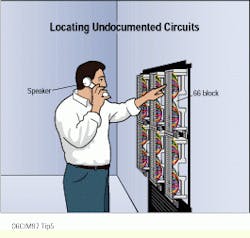Rick Waddell,
Vikimatic Sales Inc.
Problem
When using a tone generator from the station side, you normally have to use a probe to carefully touch each contact to pick up and amplify the signal at the other end of the cable. If you touch two contacts simultaneously, you risk a short circuit, which can blow a fuse in a telephone switch or port, or in a card in a hub.
Solution
Instead of using the tip of the probe to find the tone, place your finger on the metal tip, which serves as the conductor. The process should help find undocumented circuits, with minimal risk to sensitive equipment.
Procedure
1) Make sure that your equipment contains good batteries.
2) Connect the tone generator at the station end of the cable for the cable you want to trace.
3) When searching for a tone on 66 punchdown blocks, hold your probe, or inductive amplifier, and place your finger on the metal tip. Place the speaker to your ear.
4) With the index finger of your other hand, touch the contacts on the punchdown blocks. You can start from the top left or the lowest numbered drop, and run your finger down the block until the tone is found. The tone will have a low volume.
5) Once you have located your tone, you can place the probe directly on the contacts to verify the pair you are seeking, saving considerable time.
Note: Because you are touching an electrical conductor, you could experience a mild shock. Also, some manufacturers now produce probes that have plastic tips, which eliminate the risk of shorting circuits.
A technician uses his finger as a probe to find undocumented circuits, while holding the speaker to his ear. Because some probes have metal tips, a fuse can be blown if two of the contacts in a 66 block are touched simultaneously.
Rick Waddell is regional sales manager for Vikimatic Sales Inc. (Lewisville, TX).

